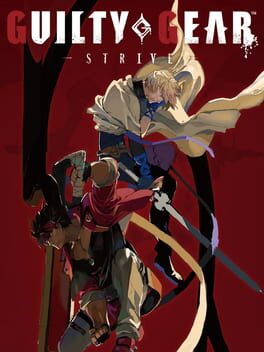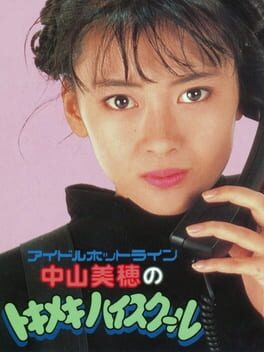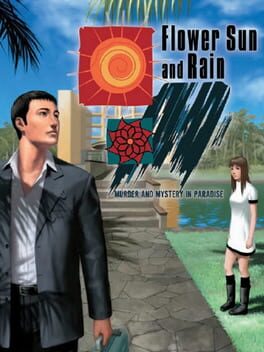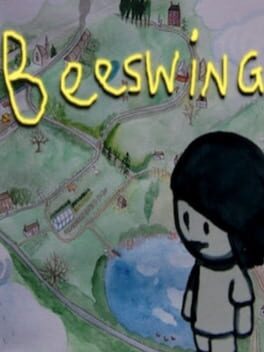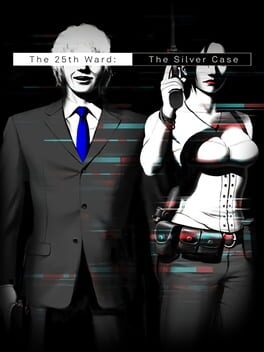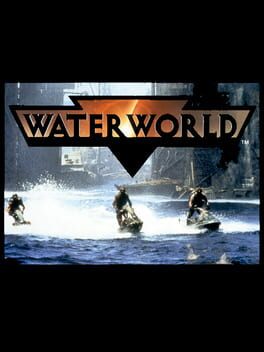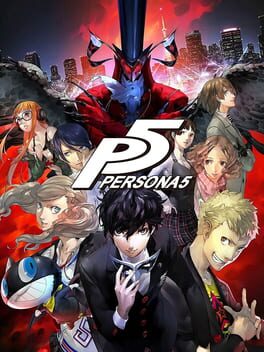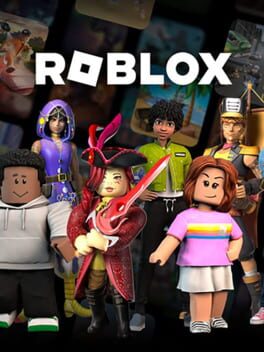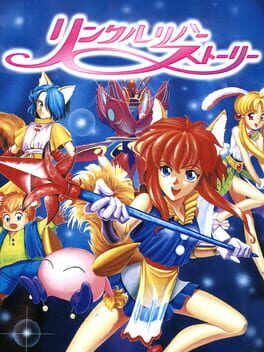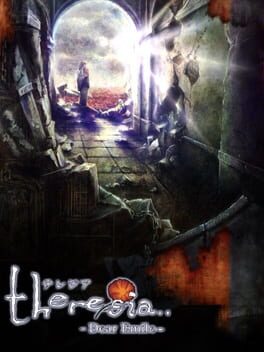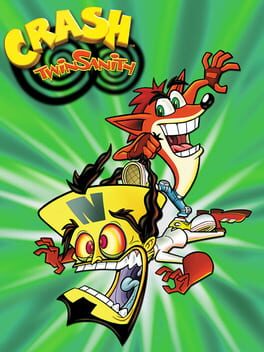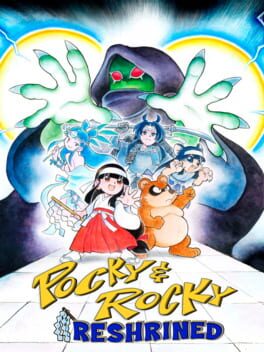6035 Reviews liked by MobileSpider
PowerWash Simulator
2022
Guilty Gear: Strive
2021
well lads they made guilty gear for everybody rather than just insane people [humming and hawing, muttering noises, sounds of consternation, air of uncertainty fills the room] however they also made testament genderfluid [rapturous applause, hi-fives, screams of joy, hugs, buncha guys start making out
The ancestor to the modern Dating Sim (the first game to even be labeled as one), this little idol game with a surprising amount of big names behind it may not have the most complex story that'd likely be considered played out today or gameplay for something that uses the same style as the Adventure games that came before it (although in certain aspects like the Cafe Date, Piano, and Roof, it loves to use the same amount of obtuseness...) but it makes up for it with the little nuances in how you have to go about conversations and dates with the Nakayama Miho/Miporin. I like it, even if it's a little trial and error. Thankfully losing a date puts you right back at the start of that conversation. It's just the final one you gotta watch out for which is not so forgiving.
As the founder of the Dating Simulator, it's a neat piece of history. As a game itself, it's a solid concept with a few frustrating elements. If you're just curious for the history, don't be afraid to use a guide if you get stuck!
Thanks for contributing to the invention of an entire genre, Miporin!
As the founder of the Dating Simulator, it's a neat piece of history. As a game itself, it's a solid concept with a few frustrating elements. If you're just curious for the history, don't be afraid to use a guide if you get stuck!
Thanks for contributing to the invention of an entire genre, Miporin!
Beeswing
2014
there should be more games like this. handcrafted watercolor collage landscapes and interiors which feel like someone rifled through old paintings kept in a drawer somewhere, reliving moments from their life with emotions potent, amplified through soft tones of bleeding pigment. mistakes and rough edges aren't flaws - they make the images alive. music emanates from the heart veiled just behind this gentle canvas, connecting with yours. revealing yours, pushing the mess of daily life aside to bring all the pain and joy you've known into relief. the most comforting ache. if love can be a video game...
Waterworld
1995
Persona 5
2016
Asura's Wrath
2012
I have always been interested in trying out this game as it always leaving the impression of being Metal Gear Rising but with planet sized dude gods doing planet sized dude godhood against one another, but little did I know I was downloading the worst excuse of a 'game' I would ever experience.
One hour of my life never ever felt this wasted:
-Visuals? More like epilepsy generator. All over the place and things are barely visible
-Writing? Koren MMORPG-tier at the very best
-Combat? Its like playing 'try finding a dumber and the less satisfying masher challenge' on a very hard mode
-Level design? Oh well you get only one small room in some of the chapters, literally non-existant
-Pacing? Only thing that actually has speed that of a god
-Ending? Well now we need to buy that one DLC
-Gameplay? Perma QTE... but here is the catch, in every other alternative QTEs exist to give cutscenes some bits of interactivity to make the experience tad bit more immersive... but here? It is literally non-stop cutscenes that are not even being affected by your inputs (neither right or wrong) and just exist to give out the scores nobody cares about
-Cover? Sick.
One hour of my life never ever felt this wasted:
-Visuals? More like epilepsy generator. All over the place and things are barely visible
-Writing? Koren MMORPG-tier at the very best
-Combat? Its like playing 'try finding a dumber and the less satisfying masher challenge' on a very hard mode
-Level design? Oh well you get only one small room in some of the chapters, literally non-existant
-Pacing? Only thing that actually has speed that of a god
-Ending? Well now we need to buy that one DLC
-Gameplay? Perma QTE... but here is the catch, in every other alternative QTEs exist to give cutscenes some bits of interactivity to make the experience tad bit more immersive... but here? It is literally non-stop cutscenes that are not even being affected by your inputs (neither right or wrong) and just exist to give out the scores nobody cares about
-Cover? Sick.
Super Mario Sunshine
2002
to the best of my knowledge, character movement exists within giant state machines dictated by the player input and the properties of any current collision. if you touch a slope, transition to sliding state; if you press the jump button, transition to a jump state unless you're sliding or etc. etc.. in those behind-the-scenes tales of miyamoto meticulously testing mario's movement in low-poly sandboxes during sm64's development, these state transitions and their corresponding kinematics values were the real meat of the tweaks on the programmers' end. "let's make the flip jump transition available even before the turn animation begins, also if mario jumps onto a slope less steep than X degrees maybe we could try giving him a few frames standing or moving to give the player some time to jump again, also if you collide in the air with a slope steeper than X degrees make sure you don't add horizontal momentum when you transition to a slide" these are just ideas off the top of my head and don't represent the actual code, but this is how I conceive of it. the character is a tightly tuned system that functions as a simulacrum of real movement, realistic where our brain wants it and exaggerated where our hands desire it. code with the model ingrained into its logic teeters the line between pretty and messy, and sm64 perhaps got the closest in its era to actually getting somewhere with this system.
sunshine unfortunately lacks this level of polish. mario's main movement feels tighter and more responsive than in the game's predecessor, but at the same time the introduction of fludd and of dynamic object geometry strains whatever was in the previous character state table. accordingly mario feels at his most chaotic in this entry. floating into a slope could result in him suddenly sliding away with no ability for the player to break out of his helplessness, or a rotating platform could cause mario to stutter as the line between "flat" and "slope" becomes blurred. mario will legitimately phase through objects on the rare occasion he doesn't clip in and out or plummet out of the sky having lost his jump. this distinct lack of polish (likely due to the game's rushed development) pervades each aspect of the game.
second-to-second these movement quirks will likely be the most apparent issue to the player, but zooming out reveals level design and structure indicative of the game's troubled history. immediately out of the gate: no star (or rather "shine sprite") requirements, with the first seven shines of each main area now mandatory and the rest completely optional and pointless outside of bragging rights. the seventh shine of each is a brief shadow mario chase that varies little from location-to-location, leaving just the first six of each area as notable challenges. so how do these stack up?
many of these (at least one per world) are obnoxious "secret" stages that steal mario from the sunkissed vista of isle delfino and drop him into gussied-up debug rooms. the level design here mainly consists of a few half-hearted platforming challenges made from hastily-assembled generic blocks slapped together with a smattering of coins and 1UPs, and none of them are very fun. the rotating objects that mario must ride in a few of these especially aggravate that previously-mentioned unstable character state table, and mastering them requires a frustrating level of practice given how unnatural the physics of these sections are. of special note is the infamous chuckster level, which involves having mario awkwardly thrown from platform to platform over death pits with restricted influence from the player. talking to each chuckster at a slight offset will result in getting thrown at angles that will often result in certain demise, and learning how to best exploit them again requires more frustrating practice in a stage that should be otherwise brief. all of this is exacerbated by the fact that you have no access to fludd, leaving mario with solely the sideflip and the spin jump. these are good moves in their own right, but I can't help but miss a low-and-long movement option like the long jump, or potentially a high vertical option that doesn't require the control stick shenanigans the sideflip/spin jump necessitate.
removing all of the secret stages (of which there are ten) and all of the shadow mario (of which there are seven) yields just 32 unique shines as part of the main game. some more categories of stages quickly become apparent:
sunshine is often criticized for its number of red coin stages, and while the postgame adds one to each secret stage along with a couple other optional ones, the main game itself features just five. the windmill village and pirate ship ones are more traditional platforming challenges, and I'd say the windmill village one is a solid exploration of the titular area in bianco hills. the pirate ship one is frustrating given the difficulty of staying put on the actual pirate ships, but the majority of the red coins are on climbable grating and are much more straight-forward to obtain. the coral reef red coin challenge revolves around sunshine's spotty swimming mechanics (questionable for a game with such a focus on watery environments) and ultimately boils down to a game of I Spy with a fiddly camera. there is also one using the rideable bloopers in ricco harbor (I often failed this one after collecting all the coins by crashing into the pier with the shine on it, which surprisingly enough didn't kill me playing on the 3DAS version), and one that takes place with the underwater scuba controls within a large bottle, which I can't really say is particularly interesting given how few obstacles there are in your way.
boss stages appear frequently throughout each world to little surprise from players of sm64 prior. bianco hills features petey pirahna, whose mouth must be filled with water before he spits sludge at you. his first fight is pretty on-par for what I'd expect from a first boss fight, and his refight is pretty similar with a couple little additions, such as flying about the main area and creating tornados (?). gooper blooper appears no less than three times throughout the game and severely wears out his welcome by his noki bay appearance, although this is proceeded by a legitimate platforming challenge that makes up for it. of note is that his first two ricco harbor appearances are virtually identical except for that one fight requires one extra spin jump in order to reach the arena. wiggler, mecha-bowser (who you fight with rockets from a rollercoaster car), the manta, king boo, and eely-mouth all have singular fights throughout the other worlds that generally are the better shines of their respective worlds. they fall about on the level I would expect from a 3D platformer: not necessarily enthralling, but decent diversions from the actual platforming.
there are also three il piantissimo races akin to koopa the quick from sm64. I would say some of the latter's races are somewhat challenging, whereas the former's chosen routes leave a lot to be desired and thus can easily be thwarted by anyone with a reasonable understanding of the controls. they unfortunately feel like 30-second throwaway shines. there is also a time attack on the rideable bloopers with a couple minor obstacle that seem pulled right out of the secret stages.
all of the above shines removed from the total, we now have 13 shines left. in theory these are the "interesting" objectives, the ones that would hopefully pop up when reminiscing about what made this game special. when I look at this list, the first one that pops out to me is sand bird... the infamous filter for many new players, including myself when I first finished this game. this stage actually involves collecting red coins, although this objective is somewhat auxillary considering the first seven can be scooped up in less than 15 seconds and the final one can't be reached until the bird that you stand upon finally reaches the top of the tower in the middle of the area. rather, the main obstacle is simply that the bird rolls 90 degrees, releasing you into the ether if you don't scramble over onto the bird's side before it completely rotates. learning to correctly time mario's walk over the edge between the different faces of one of the bird's many cubes (I usually do it at the tail) is entirely unintuitive and unforgiving. once it clicks, the stage becomes an auto-scroller without any point or challenge, as it has the last couple times I've played it. there is no sweet spot in the middle where the shine feels obtainable with some effort; it either feels insurmountable when you're first trying it and then rote on each subsequent playthrough.
this describes a lot of these remaining shines unfortunately, especially when it comes to the proper platforming challenges in each stage. the caged shine sprite in ricco harbor atop a large structure of steel girders caused me to tear my hair out initially with the wind sprites that assault you, requiring a full tower reclimb; on this attempt I forgot the intended path and instead skipped about 60% of the area with a well-timed spin jump. the runaway ferris wheel stage in pinna park had the same result for me: on my original playthrough I struggled greatly with the electrified koopas and their unpredictable movement cycles, whereas on this playthrough I skipped past the entire top half of the climbable grating with another spin jump, making the challenge moot. simply knowing the movement tech completely obliterates the challenge, and yet I feel obligated to do it because without using it I'm thrust into the jank. the same goes for those who know how to use the spam spray: timed slime-clearing levels such as the one in sirena beach are incessently precise without knowing how to shotgun your water blasts, but once you do they become pointlessly easy. simply knowing discrete strategies or moves renders the game moot, and thus there is no linear difficulty curve. between my first playthrough and now there is simply a void where a fun game should be; never has sunshine felt like a accessible trial to be overcome. there is simply a gulf between aggravation and tedium.
this is to say nothing of the hub, the optional content, the one-of-a-kind environmental throughline, hell, even fludd itself. it just all feels... slight in its rushed nature and uneven scope. levels are expansive but exploration is heavily discouraged given how scripted many of the individual shines are, and on this playthrough I felt like I missed entire swaths of each level. new fludd abilities or yoshi aren't given bespoke unlock levels such as in sm64, and instead simply are dropped from even more shadow mario chases. the plaza hub does come to life more and more as the game continues, but compared to peach's castle it lacks progression even as it opens up new challenges (among which are the particularly infamous sunshine levels everyone discusses like pachinko or the lilypad death river). the one thing that keeps me going is that sense of locality that few other games of this era can point to, that feeling of seeing the ferris wheel far off in the background of another stage, or the hotel delfino off in the distance. no other game I can think of attempts something so drastically removed from typical delineation of themes between areas like sunshine, and it's a shame that it jettisons a lot of its potential by flooding the shine list with these dripless special stages in a floating void.
in many ways I don't see sunshine as truly mechanically paired with 64 as the "collectathon" mario games. in fact, I don't think 64 was even intended as a collectathon as we understand them today; instead its explorable areas feel more like opportunity seized from technical restraints preventing true linear platforming challenges from really succeeding. sunshine attempts to move more in the latter direction, without the same sense of non-linearity or potentiality that arose from 64's seeming vastness at the time. in this regard it feels more like an ancestor to galaxy; galaxy is hatched from the egg of sunshine, something with the same genes as 64 but woven within a new form and flesh. it may have even been genius in its own right had it not been hastily released in an attempt to bolster the gamecube's faltering performance. in another way it's the reverse of much of nintendo's modern "meh"-tier output: full of soul but completely unpolished.
sunshine unfortunately lacks this level of polish. mario's main movement feels tighter and more responsive than in the game's predecessor, but at the same time the introduction of fludd and of dynamic object geometry strains whatever was in the previous character state table. accordingly mario feels at his most chaotic in this entry. floating into a slope could result in him suddenly sliding away with no ability for the player to break out of his helplessness, or a rotating platform could cause mario to stutter as the line between "flat" and "slope" becomes blurred. mario will legitimately phase through objects on the rare occasion he doesn't clip in and out or plummet out of the sky having lost his jump. this distinct lack of polish (likely due to the game's rushed development) pervades each aspect of the game.
second-to-second these movement quirks will likely be the most apparent issue to the player, but zooming out reveals level design and structure indicative of the game's troubled history. immediately out of the gate: no star (or rather "shine sprite") requirements, with the first seven shines of each main area now mandatory and the rest completely optional and pointless outside of bragging rights. the seventh shine of each is a brief shadow mario chase that varies little from location-to-location, leaving just the first six of each area as notable challenges. so how do these stack up?
many of these (at least one per world) are obnoxious "secret" stages that steal mario from the sunkissed vista of isle delfino and drop him into gussied-up debug rooms. the level design here mainly consists of a few half-hearted platforming challenges made from hastily-assembled generic blocks slapped together with a smattering of coins and 1UPs, and none of them are very fun. the rotating objects that mario must ride in a few of these especially aggravate that previously-mentioned unstable character state table, and mastering them requires a frustrating level of practice given how unnatural the physics of these sections are. of special note is the infamous chuckster level, which involves having mario awkwardly thrown from platform to platform over death pits with restricted influence from the player. talking to each chuckster at a slight offset will result in getting thrown at angles that will often result in certain demise, and learning how to best exploit them again requires more frustrating practice in a stage that should be otherwise brief. all of this is exacerbated by the fact that you have no access to fludd, leaving mario with solely the sideflip and the spin jump. these are good moves in their own right, but I can't help but miss a low-and-long movement option like the long jump, or potentially a high vertical option that doesn't require the control stick shenanigans the sideflip/spin jump necessitate.
removing all of the secret stages (of which there are ten) and all of the shadow mario (of which there are seven) yields just 32 unique shines as part of the main game. some more categories of stages quickly become apparent:
sunshine is often criticized for its number of red coin stages, and while the postgame adds one to each secret stage along with a couple other optional ones, the main game itself features just five. the windmill village and pirate ship ones are more traditional platforming challenges, and I'd say the windmill village one is a solid exploration of the titular area in bianco hills. the pirate ship one is frustrating given the difficulty of staying put on the actual pirate ships, but the majority of the red coins are on climbable grating and are much more straight-forward to obtain. the coral reef red coin challenge revolves around sunshine's spotty swimming mechanics (questionable for a game with such a focus on watery environments) and ultimately boils down to a game of I Spy with a fiddly camera. there is also one using the rideable bloopers in ricco harbor (I often failed this one after collecting all the coins by crashing into the pier with the shine on it, which surprisingly enough didn't kill me playing on the 3DAS version), and one that takes place with the underwater scuba controls within a large bottle, which I can't really say is particularly interesting given how few obstacles there are in your way.
boss stages appear frequently throughout each world to little surprise from players of sm64 prior. bianco hills features petey pirahna, whose mouth must be filled with water before he spits sludge at you. his first fight is pretty on-par for what I'd expect from a first boss fight, and his refight is pretty similar with a couple little additions, such as flying about the main area and creating tornados (?). gooper blooper appears no less than three times throughout the game and severely wears out his welcome by his noki bay appearance, although this is proceeded by a legitimate platforming challenge that makes up for it. of note is that his first two ricco harbor appearances are virtually identical except for that one fight requires one extra spin jump in order to reach the arena. wiggler, mecha-bowser (who you fight with rockets from a rollercoaster car), the manta, king boo, and eely-mouth all have singular fights throughout the other worlds that generally are the better shines of their respective worlds. they fall about on the level I would expect from a 3D platformer: not necessarily enthralling, but decent diversions from the actual platforming.
there are also three il piantissimo races akin to koopa the quick from sm64. I would say some of the latter's races are somewhat challenging, whereas the former's chosen routes leave a lot to be desired and thus can easily be thwarted by anyone with a reasonable understanding of the controls. they unfortunately feel like 30-second throwaway shines. there is also a time attack on the rideable bloopers with a couple minor obstacle that seem pulled right out of the secret stages.
all of the above shines removed from the total, we now have 13 shines left. in theory these are the "interesting" objectives, the ones that would hopefully pop up when reminiscing about what made this game special. when I look at this list, the first one that pops out to me is sand bird... the infamous filter for many new players, including myself when I first finished this game. this stage actually involves collecting red coins, although this objective is somewhat auxillary considering the first seven can be scooped up in less than 15 seconds and the final one can't be reached until the bird that you stand upon finally reaches the top of the tower in the middle of the area. rather, the main obstacle is simply that the bird rolls 90 degrees, releasing you into the ether if you don't scramble over onto the bird's side before it completely rotates. learning to correctly time mario's walk over the edge between the different faces of one of the bird's many cubes (I usually do it at the tail) is entirely unintuitive and unforgiving. once it clicks, the stage becomes an auto-scroller without any point or challenge, as it has the last couple times I've played it. there is no sweet spot in the middle where the shine feels obtainable with some effort; it either feels insurmountable when you're first trying it and then rote on each subsequent playthrough.
this describes a lot of these remaining shines unfortunately, especially when it comes to the proper platforming challenges in each stage. the caged shine sprite in ricco harbor atop a large structure of steel girders caused me to tear my hair out initially with the wind sprites that assault you, requiring a full tower reclimb; on this attempt I forgot the intended path and instead skipped about 60% of the area with a well-timed spin jump. the runaway ferris wheel stage in pinna park had the same result for me: on my original playthrough I struggled greatly with the electrified koopas and their unpredictable movement cycles, whereas on this playthrough I skipped past the entire top half of the climbable grating with another spin jump, making the challenge moot. simply knowing the movement tech completely obliterates the challenge, and yet I feel obligated to do it because without using it I'm thrust into the jank. the same goes for those who know how to use the spam spray: timed slime-clearing levels such as the one in sirena beach are incessently precise without knowing how to shotgun your water blasts, but once you do they become pointlessly easy. simply knowing discrete strategies or moves renders the game moot, and thus there is no linear difficulty curve. between my first playthrough and now there is simply a void where a fun game should be; never has sunshine felt like a accessible trial to be overcome. there is simply a gulf between aggravation and tedium.
this is to say nothing of the hub, the optional content, the one-of-a-kind environmental throughline, hell, even fludd itself. it just all feels... slight in its rushed nature and uneven scope. levels are expansive but exploration is heavily discouraged given how scripted many of the individual shines are, and on this playthrough I felt like I missed entire swaths of each level. new fludd abilities or yoshi aren't given bespoke unlock levels such as in sm64, and instead simply are dropped from even more shadow mario chases. the plaza hub does come to life more and more as the game continues, but compared to peach's castle it lacks progression even as it opens up new challenges (among which are the particularly infamous sunshine levels everyone discusses like pachinko or the lilypad death river). the one thing that keeps me going is that sense of locality that few other games of this era can point to, that feeling of seeing the ferris wheel far off in the background of another stage, or the hotel delfino off in the distance. no other game I can think of attempts something so drastically removed from typical delineation of themes between areas like sunshine, and it's a shame that it jettisons a lot of its potential by flooding the shine list with these dripless special stages in a floating void.
in many ways I don't see sunshine as truly mechanically paired with 64 as the "collectathon" mario games. in fact, I don't think 64 was even intended as a collectathon as we understand them today; instead its explorable areas feel more like opportunity seized from technical restraints preventing true linear platforming challenges from really succeeding. sunshine attempts to move more in the latter direction, without the same sense of non-linearity or potentiality that arose from 64's seeming vastness at the time. in this regard it feels more like an ancestor to galaxy; galaxy is hatched from the egg of sunshine, something with the same genes as 64 but woven within a new form and flesh. it may have even been genius in its own right had it not been hastily released in an attempt to bolster the gamecube's faltering performance. in another way it's the reverse of much of nintendo's modern "meh"-tier output: full of soul but completely unpolished.
Roblox
2006
i'm not oblivious to the irony of my feelings about this trash. when i was in my teens, magazines like egm and gamefan loved to report on joseph lieberman's campaign against violence in video games. he and his fellow senators didn't really get it, and even as kids we knew better. better than them, better for ourselves. mortal kombat was and always has been looney tunes, but these crusty old politicians took it seriously - at least enough to raise funds from clueless conservative parents. this whole era tilled the soil from which gamergate would sprout a couple of decades later. censorship was the enemy, no matter what considerations might motivate the direction of art or changes to it.
(a couple of side notes: howard lincoln, president of nintendo america in 1993, said that year that night trap would never appear on a nintendo system. well, he was wrong about that. also, it's pretty interesting to see these guys wring their hands about konami's justifier lightgun "teaching children that any problem can be solved with a gun" when we consider the world we live in - at least in the us - today. lightguns are pretty much a thing of the past, and i feel like it's a safe bet that kids who played lethal enforcers didn't all go on to become cops. but if they did, well, then i don't imagine lieberman has anything negative to say about them. i'm quite sure he's not thinking about what a tragedy it is that some old video games "justified" them becoming the violent foot soldiers of the white supremacist state. and how would we ever know if even a single cop in 2022 ever played lethal enforcers, anyway? what the fuck am i even talking about?)
here i am, well into my adulthood and reading articles about a fascist recruitment campaign which happened in roblox, thinking i'd like to make it my mission to get my nephews away from this junk. initially i frowned upon learning that the elder of my nephews was playing lots of this because, well, it's fucking devoid of any sort of aesthetic quality. funko pop shit. and, in fairness, my nephews are still young and easily distracted and who the fuck am i anyway, i'm literally talking in irc in between paragraphs here about cruelty squad and the worldview of its developer, who is supposedly anti-capitalist, though he also collaborated with the brigador devs not long after they were exposed as something awful forum posters into white nationalism and holocaust denial or whatever, and i find the whole situation frankly fucking bewildering and idk if i want to play this game (cruelty squad) which otherwise seems to be, incidentally, the exact inverse of a game like roblox... but is it really? jfc i really am an idiot. sometimes nothing makes sense. it's not like i'm afraid of some level of depravity... i mean, have you seen the movies and music i'm into? but i mean, despite my depression and the world i'm not a doomer or a nihilist. the red pill is a metaphor in the matrix, a movie that whips ass, not the hateful bullshit some 4chan nerds equate with being "based." all of this is so much weirder and more unsettling to me than mortal goddamn kombat ever even came close to being.
look, i mean... i don't want to approach my nephews as a lieberman, as some arbiter of content safe for consumption with a stick up their ass. still, one thing i do know: roblox is shit and the kids could do better. play a fucking dragon quest. discover culture, idk. maybe even go outside, learn how to be alone.
(a couple of side notes: howard lincoln, president of nintendo america in 1993, said that year that night trap would never appear on a nintendo system. well, he was wrong about that. also, it's pretty interesting to see these guys wring their hands about konami's justifier lightgun "teaching children that any problem can be solved with a gun" when we consider the world we live in - at least in the us - today. lightguns are pretty much a thing of the past, and i feel like it's a safe bet that kids who played lethal enforcers didn't all go on to become cops. but if they did, well, then i don't imagine lieberman has anything negative to say about them. i'm quite sure he's not thinking about what a tragedy it is that some old video games "justified" them becoming the violent foot soldiers of the white supremacist state. and how would we ever know if even a single cop in 2022 ever played lethal enforcers, anyway? what the fuck am i even talking about?)
here i am, well into my adulthood and reading articles about a fascist recruitment campaign which happened in roblox, thinking i'd like to make it my mission to get my nephews away from this junk. initially i frowned upon learning that the elder of my nephews was playing lots of this because, well, it's fucking devoid of any sort of aesthetic quality. funko pop shit. and, in fairness, my nephews are still young and easily distracted and who the fuck am i anyway, i'm literally talking in irc in between paragraphs here about cruelty squad and the worldview of its developer, who is supposedly anti-capitalist, though he also collaborated with the brigador devs not long after they were exposed as something awful forum posters into white nationalism and holocaust denial or whatever, and i find the whole situation frankly fucking bewildering and idk if i want to play this game (cruelty squad) which otherwise seems to be, incidentally, the exact inverse of a game like roblox... but is it really? jfc i really am an idiot. sometimes nothing makes sense. it's not like i'm afraid of some level of depravity... i mean, have you seen the movies and music i'm into? but i mean, despite my depression and the world i'm not a doomer or a nihilist. the red pill is a metaphor in the matrix, a movie that whips ass, not the hateful bullshit some 4chan nerds equate with being "based." all of this is so much weirder and more unsettling to me than mortal goddamn kombat ever even came close to being.
look, i mean... i don't want to approach my nephews as a lieberman, as some arbiter of content safe for consumption with a stick up their ass. still, one thing i do know: roblox is shit and the kids could do better. play a fucking dragon quest. discover culture, idk. maybe even go outside, learn how to be alone.
Linkle Liver Story
1996
I’m going to list a few traits below and I’d like you to guess what game I’m referring to:
- Top-down Zelda-inspired combat with absurdly small hit detection
- Charge attack that sends a boomerang-like projectile forward
- Moveset consisting of jumps and a dash that utilizes momentum-based drifting
- Floating companion creature whose abilities change depending on equipment preferences
- Linear adventure areas connected via an overworld map
- Villages with talking animals
- Using apples to refill health
- Surprisingly convoluted story about the origin of life
- Complete disregard for any sense of mechanical or narrative pacing
- Can be easily completed in a few short play sessions
- Ends with a beautiful calligraphy “FIN”
It might seem like I’m describing Linkle Liver Story. That’s because I am! But I’m also describing Nextech’s previous game released only a short two years prior: Crusader of Centy. It’s almost comical how perfectly identical these two games are.
Since it’s impossible to divorce Linkle Liver Story from the shadow of Crusader of Centy, I also regret to report that Crusader of Centy nearly does everything better. Crusader of Centy’s narrative focus on prejudice and miscommunication feels a lot more inspired and poignant than Linkle Liver Story’s musings about the impermanence of naturalistic life. I’ll give Linkle Liver Story that its protagonist’s controls feel more polished and refined, though its enemies are significantly more annoying and its weapon-growing system does not offer nearly as many strategic or personalization opportunities as it seems to hope it does.
Of course, this is all neglecting one crucial detail: in Linkle Liver Story, you can Naruto run as a foxgirl. So maybe it’s better than Crusader of Centy after all
- Top-down Zelda-inspired combat with absurdly small hit detection
- Charge attack that sends a boomerang-like projectile forward
- Moveset consisting of jumps and a dash that utilizes momentum-based drifting
- Floating companion creature whose abilities change depending on equipment preferences
- Linear adventure areas connected via an overworld map
- Villages with talking animals
- Using apples to refill health
- Surprisingly convoluted story about the origin of life
- Complete disregard for any sense of mechanical or narrative pacing
- Can be easily completed in a few short play sessions
- Ends with a beautiful calligraphy “FIN”
It might seem like I’m describing Linkle Liver Story. That’s because I am! But I’m also describing Nextech’s previous game released only a short two years prior: Crusader of Centy. It’s almost comical how perfectly identical these two games are.
Since it’s impossible to divorce Linkle Liver Story from the shadow of Crusader of Centy, I also regret to report that Crusader of Centy nearly does everything better. Crusader of Centy’s narrative focus on prejudice and miscommunication feels a lot more inspired and poignant than Linkle Liver Story’s musings about the impermanence of naturalistic life. I’ll give Linkle Liver Story that its protagonist’s controls feel more polished and refined, though its enemies are significantly more annoying and its weapon-growing system does not offer nearly as many strategic or personalization opportunities as it seems to hope it does.
Of course, this is all neglecting one crucial detail: in Linkle Liver Story, you can Naruto run as a foxgirl. So maybe it’s better than Crusader of Centy after all
Theresia
2008
PLAY THIS GAME.
Theresia is my favorite game. It's an extremely deep and interesting story that could be compared to some of the horror greats, such as Silent Hill 2 and Rule of Rose. It's gameplay is point and click mixed with dungeon crawler- and unfortunately, the first chapter of Theresia is unfortunately the worst regarding the gameplay- it clocks in as long as Theresia's prequel.
I refuse to talk on the story- but it deals with some very mixed feelings and overall a balance of "beauty and ugliness" within scenarios. It's a very interesting game story wise. I probably shouldn't give it a 5 star review based off the sometimes bad gameplay, but when I got obsessed with it to the point I didn't stop thinking about it for 2 years straight- you know it's good. Theresia also has a second campaign called Dear Martel (unlocked after beating the game) which is my particular favorite of the two entries- and tells of the origin of the events of the first scenario. If you can be patient enough to put up with its sometimes clunky controls, it's a gem.
Beginner tip: If you're playing this on emulator, I greatly reccomend using super speed. This game's movement is unfortunately really slow and you'll be having a better time if you play with this.
Theresia is my favorite game. It's an extremely deep and interesting story that could be compared to some of the horror greats, such as Silent Hill 2 and Rule of Rose. It's gameplay is point and click mixed with dungeon crawler- and unfortunately, the first chapter of Theresia is unfortunately the worst regarding the gameplay- it clocks in as long as Theresia's prequel.
I refuse to talk on the story- but it deals with some very mixed feelings and overall a balance of "beauty and ugliness" within scenarios. It's a very interesting game story wise. I probably shouldn't give it a 5 star review based off the sometimes bad gameplay, but when I got obsessed with it to the point I didn't stop thinking about it for 2 years straight- you know it's good. Theresia also has a second campaign called Dear Martel (unlocked after beating the game) which is my particular favorite of the two entries- and tells of the origin of the events of the first scenario. If you can be patient enough to put up with its sometimes clunky controls, it's a gem.
Beginner tip: If you're playing this on emulator, I greatly reccomend using super speed. This game's movement is unfortunately really slow and you'll be having a better time if you play with this.
Crash Twinsanity
2004
Around the end of the game, when you enter the alternate dimension that the antagonists of the game came from, Cortex remarks that there were supposed to be two dimensions, "but we ran out of time". Due to everything I had been through with this game while playing it, hearing this felt like when your friend makes a self-deprecating joke that's just a little too revealing and makes everyone uncomfortable.
I'm kind of baffled by how many people have given this game a pass when it comes to all its bugs, glitches, and general sloppiness. Don't get me wrong, this is a solid idea for a new Crash game, turning it into a more linear Jak and Daxter has its appeal and makes sense for when it came out. There are little moments where this new format works; when the platforming takes advantage of the more open levels and the crate mechanics of previous Crash games. But these moments don't last long and are replaced with mid-at-best gimmick sections. These gimmick sections start off kind of interesting, but nearly all of them immediately fall into the pitfall of the game's broken nature. Rolling around as a ball is neat until you have to make a precise jump and all of a sudden you launch thirty feet into the air. Rolling Cortex around in a barrel seems promising until one nudge rolls him off the stage immediately. Sliding stages require you to use a jump that only works half of the time, and the Nina Cortex level involves extremely brainless wall-jumping mechanics. Some stuff like Crash having to drag Cortex through levels and playing as Cortex aren't too bad, but man games in this era sure loved just giving as many different types of gameplay as possible, and considering Twinsanity is constantly falling apart, it does not do this game any favors.
But let's focus on just playing as Crash, going through levels with the usual jumping and spinning and whatnot. As I said, it sometimes works, but it often feels like they forced Crash-style platforming challenges into a 3D space and it doesn't feel great. I had several moments of falling into pits due to not being able to judge the distance of a jump, or not being able to see the jump at all, which rarely happened in previous Crash games. The worst part is anything involving platforming on steel crates, on which you can't see your shadow. This makes platforming on such sections a complete hassle, and I often ignored the gems that involved them due to how hard it was to find out how to land properly on them. In general, many of the crate bouncing challenges that are reminiscent of previous games are pretty bad here, and the game is at its best when it just acts like crates don't exist outside of TNT and nitro crates.
I have some other gripes, like how Aku Aku is basically useless since it seems every obstacle is instant death, how dogshit checkpointing can be sometimes (it really is inspired by Jak and Daxter), and the unskippable cutscenes, but really the main reason I can't recommend this game is how broken it is. I had three straight-up crashes/soft locks while playing, one of which sent me way too far back, one moment where I couldn't progress past a combat section because knocking an enemy into a pit didn't count as killing them, and a couple of moments of losing all the music for some time, and several other glitches. So many things just killed me without explanation that I went through most of the game scared for my life that a random seam on the floor would take my last life and send me back to the last autosave. Anyone else jump on that one boss's dead body, thinking it was safe, only to have it kill you and make you do the whole boss again? I could also talk about how the story feels like only half of it was told, the cutscenes that desperately need actual sound effects, and countless sloppy little things.
Obviously, no one sets out to make a game like this on purpose, it was the result of crunch, disputes between different parts of development and with the publisher, and having to scrape together different, unfinished versions of this game that went through multiple changes way too rapidly. There's a version of this game that fully realizes what Traveler's Tales set out to do, and it's sad we'll probably never see it considering the Crash series has both come back and died before it could get to giving this the full-on remake it needs. Some people can enjoy it for what it is, I personally had a rough as hell time and would not recommend this to anyone, especially since emulating it still seems to be an involved process. The music stands out as the only fully realized and wholly enjoyable part of this game. I need to stop trusting the taste of 3D platformer fans though, have you seen the way they talk about this game, it's like they played a different game I swear.
I'm kind of baffled by how many people have given this game a pass when it comes to all its bugs, glitches, and general sloppiness. Don't get me wrong, this is a solid idea for a new Crash game, turning it into a more linear Jak and Daxter has its appeal and makes sense for when it came out. There are little moments where this new format works; when the platforming takes advantage of the more open levels and the crate mechanics of previous Crash games. But these moments don't last long and are replaced with mid-at-best gimmick sections. These gimmick sections start off kind of interesting, but nearly all of them immediately fall into the pitfall of the game's broken nature. Rolling around as a ball is neat until you have to make a precise jump and all of a sudden you launch thirty feet into the air. Rolling Cortex around in a barrel seems promising until one nudge rolls him off the stage immediately. Sliding stages require you to use a jump that only works half of the time, and the Nina Cortex level involves extremely brainless wall-jumping mechanics. Some stuff like Crash having to drag Cortex through levels and playing as Cortex aren't too bad, but man games in this era sure loved just giving as many different types of gameplay as possible, and considering Twinsanity is constantly falling apart, it does not do this game any favors.
But let's focus on just playing as Crash, going through levels with the usual jumping and spinning and whatnot. As I said, it sometimes works, but it often feels like they forced Crash-style platforming challenges into a 3D space and it doesn't feel great. I had several moments of falling into pits due to not being able to judge the distance of a jump, or not being able to see the jump at all, which rarely happened in previous Crash games. The worst part is anything involving platforming on steel crates, on which you can't see your shadow. This makes platforming on such sections a complete hassle, and I often ignored the gems that involved them due to how hard it was to find out how to land properly on them. In general, many of the crate bouncing challenges that are reminiscent of previous games are pretty bad here, and the game is at its best when it just acts like crates don't exist outside of TNT and nitro crates.
I have some other gripes, like how Aku Aku is basically useless since it seems every obstacle is instant death, how dogshit checkpointing can be sometimes (it really is inspired by Jak and Daxter), and the unskippable cutscenes, but really the main reason I can't recommend this game is how broken it is. I had three straight-up crashes/soft locks while playing, one of which sent me way too far back, one moment where I couldn't progress past a combat section because knocking an enemy into a pit didn't count as killing them, and a couple of moments of losing all the music for some time, and several other glitches. So many things just killed me without explanation that I went through most of the game scared for my life that a random seam on the floor would take my last life and send me back to the last autosave. Anyone else jump on that one boss's dead body, thinking it was safe, only to have it kill you and make you do the whole boss again? I could also talk about how the story feels like only half of it was told, the cutscenes that desperately need actual sound effects, and countless sloppy little things.
Obviously, no one sets out to make a game like this on purpose, it was the result of crunch, disputes between different parts of development and with the publisher, and having to scrape together different, unfinished versions of this game that went through multiple changes way too rapidly. There's a version of this game that fully realizes what Traveler's Tales set out to do, and it's sad we'll probably never see it considering the Crash series has both come back and died before it could get to giving this the full-on remake it needs. Some people can enjoy it for what it is, I personally had a rough as hell time and would not recommend this to anyone, especially since emulating it still seems to be an involved process. The music stands out as the only fully realized and wholly enjoyable part of this game. I need to stop trusting the taste of 3D platformer fans though, have you seen the way they talk about this game, it's like they played a different game I swear.
After being pushed back twice and ultimately not shipping from Amazon dot com, I caved and picked up Pocky & Rocky: Reshrined from Gamestop. Like an absolute lunatic, I also purchased two gigantic boxes of batteries because my addled brain would rather slap an extra 25 dollars on an order and get something rather than cough up six bucks for shipping. The real question is, was all this trouble worth it?
I think so. Like Tengo Project's other releases, Reshrined does such a great job at replicating every element that made the original games work while innovating on them in a way that feels like a natural progression, you'd almost think it was released a generation apart from the originals rather than 20+ years. If anything, the most "modern" aspect about the game is how the difficulty has been scaled back. It's still certainly challenging, but unlimited continues and mid-level checkpointing after game overs makes it a lot less frustrating when you bite it. I found myself entering into a sort of Castlevania rhythm where failure only meant another chance to approach a level armed with foreknowledge of enemy patterns and item locations, and building a new route accordingly.
Pocky and Rocky still play like how you would expect them to, but you're quickly given a new technique that allows you to set crystal balls that ricochet your attacks, and a chargeable shield that reflects most incoming projectiles. These new skills can sometimes be tricky to set up, especially in later stages, but I suppose it needs to be balanced out somehow given the absolute havoc you can unleash with them. The roster is also expanded with three new characters, all of which offer more varied movesets over Pocky and Rocky. Ikazuchi is easily my favorite among the three with her homing electrical spell and snappy dodge making her feel both nimble and overpowered. I was less a fan of Ame-no-Uzume, who attacks using two Options positioned at her sides, giving her a broader base attack while leaving her open down the middle. To make up for this, she can float over bottomless pits and bodies of water, but in more narrow passageways having her spell power at 0 feels more punishing than any other character.
My one real complaint about Reshrined is that there's NOT. ENOUGH. ROCKY. Look at that little guy! You're telling me I can only play as him for three levels!? AND one of those is just a boss fight where the whole gimmick is the boss runs left and right? Get outta here... Docking a whole star for that. Yes I know I can play the whole game as him in free mode, but I've always had a hard time doing a second run of any arcade game right after finishing the first.
The game is of course great to look at. The sprite work is incredibly detailed and colorful, and you can tell a lot of care was put into the animations. There's some weird censorship in the US release where they covered up Ame-no-Uzume's chest in cutscenes, which feels a bit unnecessary but also kinda appropriate for a game that is so closely trying to emulate its 90's predecessors. Speaking of, the translation isn't great. Some lines of dialog just sound off, but maybe that's just me. The plot is fine for what it is (see: time travel shenanigans), but also bizarrely convoluted for a Pocky & Rocky game. The cutscenes can go on a bit long too, which I don't entirely mind because they are great to look at, but the pacing of free mode feels a whole lot better.
Like other Tengo helmed Natsume games, it comes at a pretty steep price for the amount of game you're getting. I prefer to look at it as supporting quality work. Reshrined takes maybe an hour or two before you're watching the credits, but the game just plays so good that I really don't mind dropping 30 bucks on it. No doubt it'll hit 10 dollars on PSN as routinely as Wild Guns Rearmed. In any case, I'm a big stupid freak for Pocky & Rocky and I just had to have it on disc along with, like, 50 AAA batteries. My cup runneth over...
I think so. Like Tengo Project's other releases, Reshrined does such a great job at replicating every element that made the original games work while innovating on them in a way that feels like a natural progression, you'd almost think it was released a generation apart from the originals rather than 20+ years. If anything, the most "modern" aspect about the game is how the difficulty has been scaled back. It's still certainly challenging, but unlimited continues and mid-level checkpointing after game overs makes it a lot less frustrating when you bite it. I found myself entering into a sort of Castlevania rhythm where failure only meant another chance to approach a level armed with foreknowledge of enemy patterns and item locations, and building a new route accordingly.
Pocky and Rocky still play like how you would expect them to, but you're quickly given a new technique that allows you to set crystal balls that ricochet your attacks, and a chargeable shield that reflects most incoming projectiles. These new skills can sometimes be tricky to set up, especially in later stages, but I suppose it needs to be balanced out somehow given the absolute havoc you can unleash with them. The roster is also expanded with three new characters, all of which offer more varied movesets over Pocky and Rocky. Ikazuchi is easily my favorite among the three with her homing electrical spell and snappy dodge making her feel both nimble and overpowered. I was less a fan of Ame-no-Uzume, who attacks using two Options positioned at her sides, giving her a broader base attack while leaving her open down the middle. To make up for this, she can float over bottomless pits and bodies of water, but in more narrow passageways having her spell power at 0 feels more punishing than any other character.
My one real complaint about Reshrined is that there's NOT. ENOUGH. ROCKY. Look at that little guy! You're telling me I can only play as him for three levels!? AND one of those is just a boss fight where the whole gimmick is the boss runs left and right? Get outta here... Docking a whole star for that. Yes I know I can play the whole game as him in free mode, but I've always had a hard time doing a second run of any arcade game right after finishing the first.
The game is of course great to look at. The sprite work is incredibly detailed and colorful, and you can tell a lot of care was put into the animations. There's some weird censorship in the US release where they covered up Ame-no-Uzume's chest in cutscenes, which feels a bit unnecessary but also kinda appropriate for a game that is so closely trying to emulate its 90's predecessors. Speaking of, the translation isn't great. Some lines of dialog just sound off, but maybe that's just me. The plot is fine for what it is (see: time travel shenanigans), but also bizarrely convoluted for a Pocky & Rocky game. The cutscenes can go on a bit long too, which I don't entirely mind because they are great to look at, but the pacing of free mode feels a whole lot better.
Like other Tengo helmed Natsume games, it comes at a pretty steep price for the amount of game you're getting. I prefer to look at it as supporting quality work. Reshrined takes maybe an hour or two before you're watching the credits, but the game just plays so good that I really don't mind dropping 30 bucks on it. No doubt it'll hit 10 dollars on PSN as routinely as Wild Guns Rearmed. In any case, I'm a big stupid freak for Pocky & Rocky and I just had to have it on disc along with, like, 50 AAA batteries. My cup runneth over...

